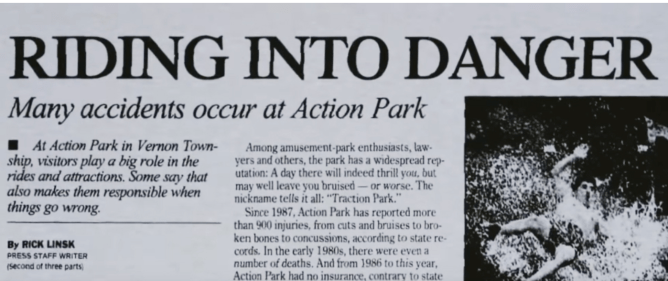By C.J. Hirschfield
The huge success of the Tiger King documentary series showed that we love watching a story about a park that is badly run by an eccentric/unsavory person, is dangerous, and ends up being an unqualified train wreck. The new HBO Max documentary Class Action Park may be about a waterpark and not an exotic zoo, the basic elements are the same, but its death count is much higher. It is a story of greed, corruption, coverups, bankruptcy, the 1980s, and ironically, some really good times as well.

My perspective on the film is unique: I ran the Children’s Fairyland storybook theme park for 17 years, and was one of the founders in 2003 of the California Attractions and Parks Association, a group organized to work with the state’s ride safety oversight regulators. I can honestly say that I watched Class Action Park with a heightened sense of horror, repulsion, and dread. But just like riding a roller coaster, the experience was ultimately positive.
Co-produced and directed by Chris Charles Scott and Seth Porges, and featuring much archival footage of what has been called “the most dangerous park of all time,” it is an excellent film that I thoroughly enjoyed.
Gene Mulvihill, the park’s owner, was a cross between Gordon Gekko, P.T. Barnum, and Donald Trump (a friend). When he was suspended by the SEC for bad behavior on Wall Street, he purchased a plot of land with two ski resorts in the bucolic town of Vernon, New Jersey, just 45 miles from the metro New York area, and began his dream to build one of the very first water parks in the world. “Higher and faster” seemed to be his credo; Action Park formally opened in 1978.

The park’s three sections: Alpine Center, Waterworld, and Motorworld were bisected by Highway 95 (!). Mulvihill designed many of the rides himself, without the benefit of professional engineers. He wanted bigger, badder and more extreme rides, created his own dummy offshore insurance company, (since no sane company would have him), ignored all labor laws, and served alcohol (right next to the racing cars, whose speed controls could be disabled). Hey, what could go wrong?
This film does a great job counting the ways, with jaw-dropping, first-hand accounts by former employees, most of whom were young teens at the time. Here are just a few examples: six deaths, including an underwater electrocution, a rider thrown out of a cart and hitting his head on rocks, and drownings. And more: countless dislocated shoulders, skin burns, and concussions. Snakes, sexual encounters, fistfights, employee hazings, and bribes offered to test unsafe rides. Attendance skyrocketed when the park began to advertise widely on television with the tagline “where the action never stops.”
Adults in the community seemingly turned a blind eye to the dangers because of jobs that the park generated, the impact on the local economy, and political payoffs.
Needless to say, teens adored the park and its lack of rules, and its real perils. The film makes the case, through those who experienced it at that time, that the eighties were very different from today. Kids had much more freedom to roam, experiment, and yes, engage in risky behavior.
The tone of the film changes markedly when we hear from a family whose teenage son died from injuries sustained at Action Park, and we realize the tragedy that greed and carelessness created. Mulvihill’s approach was to never settle, to force trials, and then not pay damages.

The filmmakers have made a film that not just documents an anarchic and controversial park but places it within the context of a very different time in our culture, when young teens ran free, and regulations were near nonexistent.
The film benefits greatly from animation reminiscent of the era by Richard Langberg, as well as original music by the Holladay Brothers.
In the end, we hear very mixed messages from Action Park employees and devotees. A particularly profane regular park attendee speaks eloquently to the contradiction. Sure, it was awful–Mulvihill. was a monster, but a colorful character, and we made some wonderful friends, romances, and memories. Nostalgia is a powerful emotion.
There is a particularly compelling style of documentary that you could call “You can’t make this stuff up,” and whether it’s a tiger zoo or a tumultuous water park, we just can’t seem to stop watching.
Class Action Park is streaming now on HBO Max.
To view the new streaming HBO Max read here.
The Class Action Park filmmaker’s website with background and article links.

 C.J. Hirschfield recently retired after 17 years as Executive Director of Children’s Fairyland, where she was charged with the overall operation of the nation’s first storybook theme park. Prior to that, she served as an executive in the cable television industry where she produced two series, ran San Francisco’s public access channel and advocated on behalf of the industry. A former writer for Film Month, she also penned a weekly column for the Piedmont Post for 13 years and now writes features and reviews for EatDrinkFilms. C.J. holds a degree in Film and Broadcasting from Stanford University.
C.J. Hirschfield recently retired after 17 years as Executive Director of Children’s Fairyland, where she was charged with the overall operation of the nation’s first storybook theme park. Prior to that, she served as an executive in the cable television industry where she produced two series, ran San Francisco’s public access channel and advocated on behalf of the industry. A former writer for Film Month, she also penned a weekly column for the Piedmont Post for 13 years and now writes features and reviews for EatDrinkFilms. C.J. holds a degree in Film and Broadcasting from Stanford University.
Hirschfield currently serves on the programming team for the Appreciating Diversity Film series showing free documentaries in Oakland and Piedmont, as well as on the advisory board of Youth Beat, a youth media training program that provides low-income Oakland students with the tools and opportunities they need to thrive in today’s workforce.
C.J. says, “A good documentary takes us places we never could never have imagined, and changes the way we see the world.”


‘People Were Bleeding All Over’: America’s Most Dangerous Amusement Park; NY Times interview with the filmmakers by James Barron.
A nine-minute compilation of commercials, home movies, and footage of the Cannonball Loop.
Weird New Jersey has written extensively about Action Park.
Defunctland is a YouTube series about failed Amusement parks and rides.
When Action Park reopened they claimed everything was safe. This is Defunctland’s story.
The Most Insane Amusement Park Ever short documentary.
